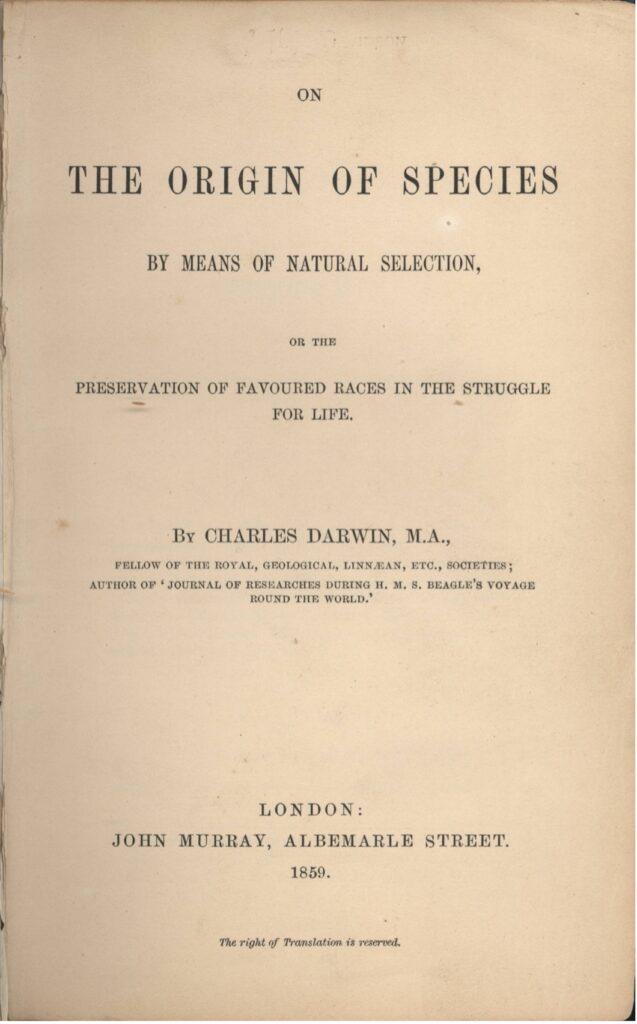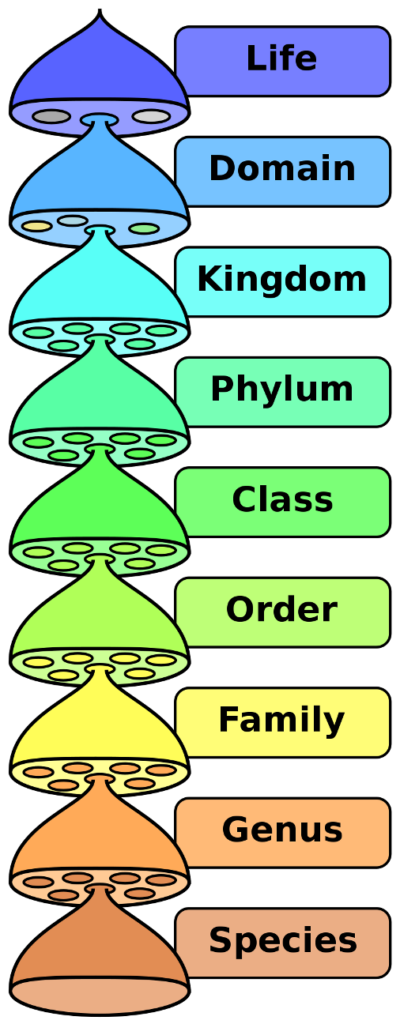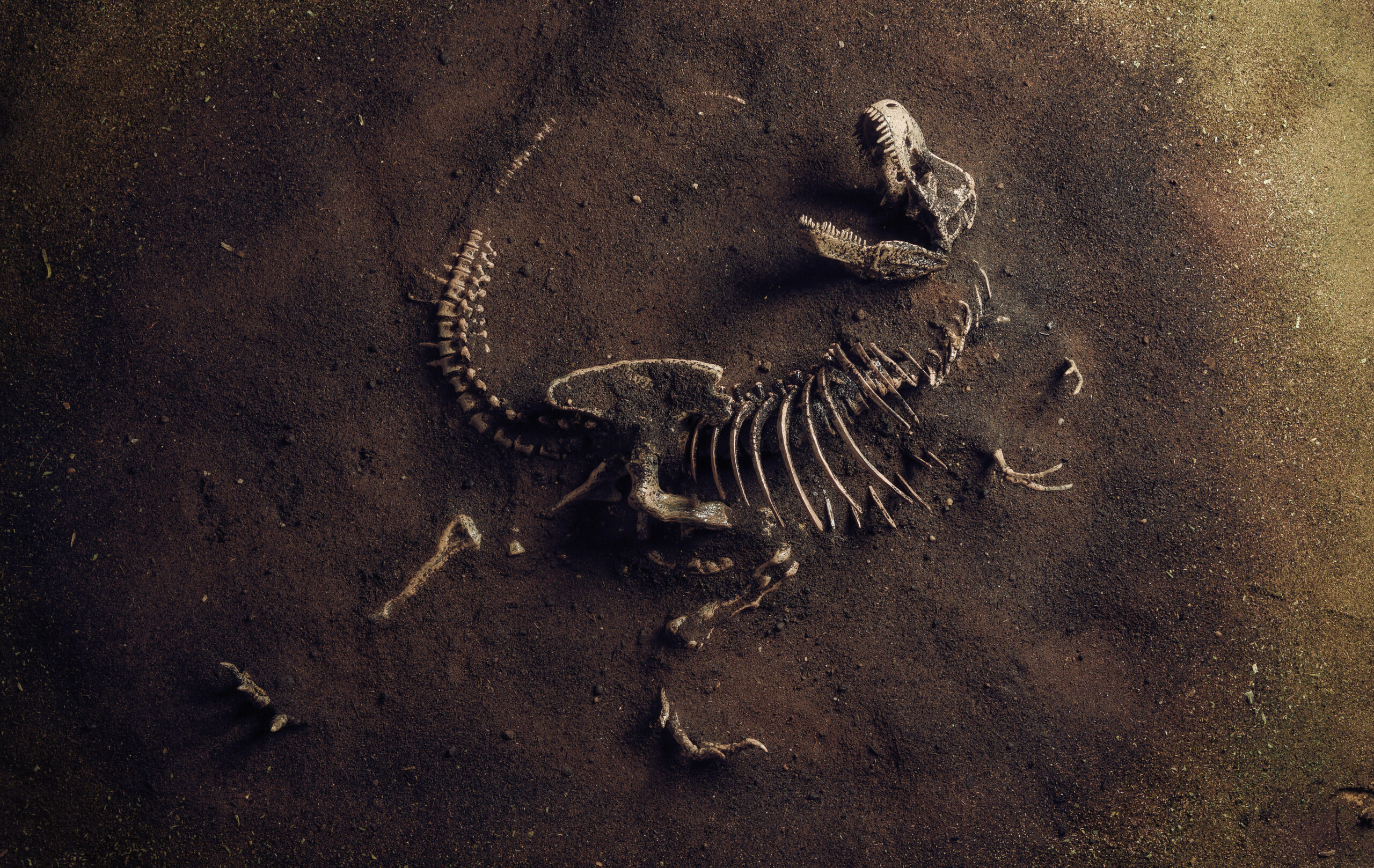Does Naturalism Explain the Fossil Record?
Any scientific model that seeks legitimacy must explain the origin and history of life. And thanks to mounting evidence, much is known about life’s history. Does that knowledge support naturalism or does supernatural creation seem more reasonable?
Darwin’s Claim
Naturalism is the hypothesis that strictly natural processes explain the origin and history of all species of life that have ever existed on Earth. With the publication of Charles Darwin’s book On the Origin of Species1 (1859) naturalism eventually became mainstream science. Darwin claimed that all life arose by common descent through a gradual branching pattern of evolution driven by natural selection from an original microbial species. He predicted that future fossil discoveries would affirm his hypothesis.
Darwin’s book (see figure 1) shook the world from its theistic complacency. Within a few decades, naturalism replaced theism as the dominant worldview among research biologists studying the history of Earth’s life. This tsunami continues to this day. In 2015, evolutionary biologist and University of Chicago professor Jerry Coyne declared in his book, Faith Versus Fact, “The greatest scripture-killer ever penned [On the Origin of Species] demolished an entire series of biblical claims by demonstrating that purely naturalistic processes—evolution and natural selection—could explain patterns in nature.”2

Credit: public domain
Naturalistic Drivers of Biological Evolution
Darwin proposed that natural selection was the sole driver of the evolution of life. Dutch botanist and geneticist Hugo de Vries demonstrated in 1901 that mutations are another significant factor. In the last few decades, evolutionary biologists have discovered two additional natural mechanisms that drive changes in life-forms: gene exchange and epigenetics.
Of the four mechanisms, natural selection and mutations play the dominant role. Gene exchange and epigenetics play minor roles, with gene exchange playing a bigger role for microbial species than it does for large-bodied organisms.
Evolutionary biologists and geneticists have searched in vain for a fifth naturalistic mechanism. If one exists, it must play a very minor role.
Fossil Record Challenges
The four known naturalistic mechanisms for generating changes in life-forms all make relatively small step changes. Mutations are capable of generating the biggest changes but the vast majority of mutations are neutral. That is, the changes they generate are neither harmful nor beneficial. Of those that are nonneutral, harmful mutations outnumber beneficial mutations by at least 10,000 to 1 and sometimes by 10,000,000 to 1. The high ratio of harmful (or deleterious) to beneficial mutations explains why ecologists observe far more extinction events than speciation events in their field studies.3
Naturalistic processes—natural selection, mutations, gene exchange, and epigenetics—all require long time periods to produce significant changes. Such changes, however, require a stable or gradually changing environment. Catastrophic environmental events will either negate the changes or result in extinction. Plus, all of these natural processes predict a bottom-up development of taxonomic hierarchy (see figure 2). That is, natural processes predict that over time they will first produce a proliferation of species, which, in much more time, will produce a proliferation of genera—and so on until one or more phyla finally appear.

Figure 2: Hierarchical Classification of the Body Structures of Organisms
Credit: Wikimedia Commons
The problem with these predictions is that the fossil record reveals the opposite: a top-down hierarchy. As paleontologists Douglas Erwin, James Valentine, and John Sepkoski have observed with respect to the Avalon and Cambrian explosions, “The major pulse of diversification of phyla occurs before that of classes, classes before that of orders, and orders before that of families.”4
The Cambrian explosion refers to the sudden appearance, 538.79 ± 0.21 million years ago,5 of animals with digestive tracts, circulatory systems, skeletons, and internal and external organs. These animals require a minimum atmospheric oxygen level of 10%, and they appear in the fossil record at the very moment that level is reached.6
The Cambrian phyla do not appear in a time-separated sequence. The most advanced phylum, chordata, the phylum to which all humans and all vertebrates belong, appears at the same time as the most primitive Cambrian phyla. It’s at the beginning, not the middle or the end of the Cambrian period. Furthermore, it is not just the nonvertebrate chordates that appear at the beginning of the Cambrian. Vertebrate fish also appear at that time.
For many decades, paleontologists were convinced that among present-day animal phyla the bryozoa phylum (animals with body sizes ranging from 0.1 to 0.9 millimeters) was exceptional in that it did not appear during the Cambrian period. Rather, the earliest bryozoa fossils appeared 60 million years later during the Tremadocian stage of the Ordovician period. However, this claim was overturned by recent discoveries of bryozoa fossils on Kangaroo Island, Australia, and in Southeast China.7 These discoveries establish that bryozoa animals appeared much earlier, at the beginning of the Cambrian period.
At that time 50 or more animal phyla appeared.8 Thirty animal phyla exist on Earth today. Of these 30, at least 28 were present during the Cambrian period with most, if not all, present at the beginning of the Cambrian.
Creation Implications
As paleontologists Kevin Peterson, Michael Dietrich, and Mark McPeek state in a review paper, “Elucidating the materialistic basis for the Cambrian explosion has become more elusive, not less, the more we know about the event itself.”9 They are not alone in drawing such conclusions. Nearly all paleontologists who have written reviews on the Cambrian explosion in the peer-reviewed scientific literature have made this concession.10
While naturalistic models cannot explain the proliferation of phyla before classes, of classes before orders, and of families before orders, a biblical creation model can. Psalm 104 implies that the God of the Bible is “on a mission” to pack Earth with as much life as possible, as diverse as possible, and for as long as possible. Such a mission ensures that when God finally creates Adam and Eve they and all their offspring will possess all the biodeposits they need to launch and sustain civilization at a level that makes the redemption of untold humans possible.11
God’s mission also requires that he ensures that just-right life is present on Earth at just-right abundances and at just-right times to perfectly compensate for the Sun’s ongoing increase in brightness and changes in its flaring activity. Today, the Sun burns 19–24% more brightly than it did at the time of life’s origin 3.8 billion years ago (see figure 3).

Figure 3: Sun’s Luminosity History
At its birth the Sun brightened quickly as it accumulated mass. During its youth, however, the Sun lost 15% or more of its mass, enough to cause more than an 80% loss of its luminosity (light emission). As it aged, its nuclear furnace converted more and more hydrogen into helium, increasing the Sun’s core density. This increasing core density results in more efficient nuclear burning. The increasingly efficient nuclear burning causes the Sun’s brightness once again to increase, gradually. The Sun’s brightening continues to this day and will one day generate so much heat energy as to make Earth uninhabitable. The dotted line indicates the current era. Credit: Hugh Ross
Normally, even a 1% alteration in solar luminosity would cause advanced plants and animals to go extinct. Avoiding such extinction requires sequentially replacing life on Earth with life-forms that more efficiently remove greenhouse gases from Earth’s atmosphere through accelerating the silicate-carbonate cycle at just-right rates.12 However, only a Mind who knows the future physics of the Sun and who possesses the power to create whatever life-forms he pleases, in whatever amounts and diversity he chooses, would be capable of ensuring that just-right life is present on Earth at just-right times.
Therefore, for multiple scientific reasons, naturalistic mechanisms are not adequate to explain the history of life on Earth. Far from “Scripture-killing,” the fossil record supports a model positing that miraculous interventions by the God of the Bible must play the predominant role.
Endnotes
- Charles Darwin, On the Origin of Species (London: John Murray, 1859).
- Jerry Coyne, Faith vs. Fact: Why Science and Religion Are Incompatible (New York: Viking, 2015), 2.
- Field studies are conducted by humans during the era of human existence. According to Genesis 1 and Psalm 104:29–30, previous to the first appearance of humans God actively created new life-forms to replace those that went extinct. However, after God created humans he ceased from creating new forms of life. This cessation explains why the appearances of new life-forms exceeded those going extinct during the prehuman era while the extinction rate greatly exceeds the speciation rate during the human epoch. The mechanisms of natural selection, mutations, gene exchange, and epigenetics can explain the few speciation events observed to occur during the human epoch.
- Douglas H. Erwin, James W. Valentine, and J. John Sepkoski Jr., “A Comparative Study of Diversification Events: The Early Paleozoic versus the Mesozoic,” Evolution 41, no. 6 (November 1, 1987): 1183, doi:10.2307/2409086.
- Ulf Linnemann et al., “New High-Resolution Age Data from the Ediacaran-Cambrian Boundary Indicate Rapid, Ecologically Driven Onset of the Cambrian Explosion,” Terra Nova 31, no. 1 (February 2019): 49–58, doi:10.1111/ter.12368.
- Michael Tatzel et al., “Late Neoproterozoic Seawater Oxygenation by Siliceous Sponges,” Nature Communications 8 (September 20, 2017): id. 621, doi:10.1038/s41467-017-00586-5; Yuntao Ye et al., “Tracking the Evolution of Seawater Mo Isotopes through the Ediacaran-Cambrian Transition,” Precambrian Research 350 (November 2020): id. 105929, doi:10.1016/j.precamres.2020.105929; Hugh Ross, “Where Did the Cambrian Oxygen Come From?” Today’s New Reason to Believe (blog), Reasons to Believe, January 24, 2022.
- Zhiliang Zhang et al., “Fossil Evidence Unveils an Early Cambrian Origin for Bryozoa,” Nature 599 (November 11, 2021): 251–55, doi:10.1038/s41586-021-04033-w.
- Roger Lewin, “A Lopsided Look at Evolution,” Science 241, no. 4863 (July 15, 1988): 291–93, doi:10.1126/science.241.4863.291.
- Kevin J. Peterson, Michael R. Dietrich, and Mark A. McPeek, “MicroRNAs and Metazoan Macroevolution: Insights into Canalization, Complexity, and the Cambrian Explosion,” BioEssays 31, no. 7 (July 2009): 737, doi:10.1002/bies.200900033.
- Jeffrey S. Levinton, “The Cambrian Explosion: How Do We Use the Evidence?” BioScience 58, no. 9 (October 2008): 855, doi:10.1641/B580912; Gregory A. Wray, “Rates of Evolution in Developmental Processes,” American Zoologist32, no. 1 (January–February, 1992): 131, doi:10.1093/icb/32.1.123.
- Hugh Ross, Improbable Planet: How Earth Became Humanity’s Home (Grand Rapids, MI: Baker Books, 2016), 168–69, 192, 196, 223–24; Hugh Ross, A Matter of Days: Resolving a Creation Controversy, 2nd ed. (Covina, CA: RTB Press, 2015), 95–97, 232–33.
- Hugh Ross, “Weathered Bedrock: Key to Advanced Life on Earth,” Today’s New Reason to Believe (blog), Reasons to Believe, May 7, 2019; Ross, Improbable Planet, 159–64.





